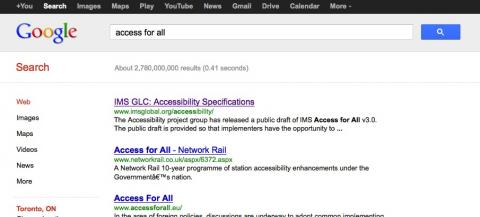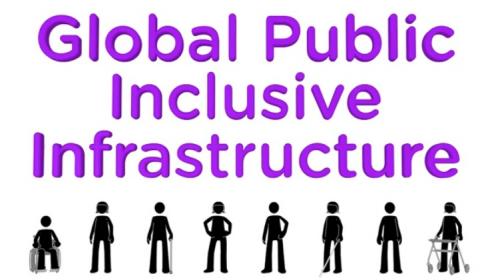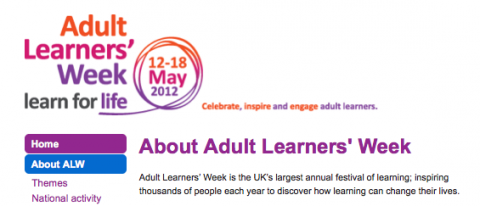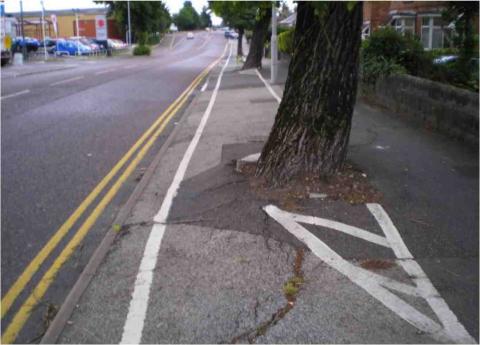Work and play in Dublin
Well we do get an hour off on an occasional evening - only occasionally mind ...
- Log in to post comments
Woo hoo - Access for All 3 top of Google Search
/>
Access for All 3 can be found here http://www.imsglobal.org/accessibility/
- Log in to post comments
Access for All 3.0 and JSON validator
Access for All JSON Validator, provided for community use courtesy of Axelrod Access for All, is at http://afa30.axelafa.com.
The validator may be used to validate JSON bindings for the IMS Access for All version 3.0 specification available at: http://www.imsglobal.org/accessibility/. It is not an IMS Global product and may not be used for IMS Certification. To achieve IMS AFA certification, visit: http://validator.imsglobal.org/accessibility/
- Log in to post comments
What follows WCAG 2.0
What follows WCAG 2.0 ? This is an insightful question.
The way I see it, WCAG and 508 have moved the picture forwards enormously and whilst achieving tight conformance is part of the picture for moving forwards for *some* kinds of products I don't see that as the entire future because on its own it creates inertia and rigidity. We are in changing times and we need flexibility and nimbleness to meet the challenges that will arise.
Technology is advancing and diversifying - that picture seems to be fragmenting. Along with that social and political changes are coming thick and fast. New but volatile markets are coming along rapidly - they come and they go - and requirements are different in each of them. So what follows WCAG 2.0 ? I think we need a new piece of the puzzle - a new paradigm that's of just the right size to take off and give some cohesion to the picture but without locking it down the way conformance work can - something that doesn't tie us into existing organisational structures (not that any of us would be keen to lose our jobs).
In my view such a piece of the puzzle is out there ready to grow - but there is work to do to grow it. Its personalisation - having only a product focus is constraining - beyond a point it cannot allow growth. But there is room for growth (and *much* better delivery of accessibility) with standards focussed not around properties of products but around user needs and requirements, to which products can adapt. This is a piece that could grow to the level that WCAG is now and move us all forwards. IMHO we need two things:
- Standard ways to express user requirements to which products can adapt
- Joining up of delivery systems across what are currently heterogeneous forms of ICT, from washing machines to ATM's to iphones to laptops to transport information systems.
With these two pieces of infrastructure things can move forwards in a big way.
There's a long way to go but work *is* underway - for example the Global Public Inclusive Infrastructure work, components of work towards which can be seen in these places:
- http://gpii.net/
- http://wiki.fluidproject.org/display/ISO24751/AccessForAll+Working+Group
- http://wiki.gpii.net/index.php/Main_Page
I believe this is the paradigm needed to move us forwards from where WCAG has got us to. Anything else would be more of the same and I think everyone would agree that something radical is needed to move things further.
andy heath
- Log in to post comments
UK Government Open Standards Consultation
Deadline 4th June 2012
Please help by following the link and responding to the consultation :
The Open Standards Consultation[1]
The History
- In 2011 the UK Government ran a consultation on Open Standards and developed a policy in favour or royalty-free Open Standards.
- After heavy lobbying by proprietary interests the consultation was run again and it would appear that the proprietaries may have the upper hand. Shenanigans, schemings and manoeuvrings may well abound.
If you agree with me please respond to the consultation on the link above and make the case to support UK businesses with an Open Standards policy.
Many have written about this issue, including [2,3,4,5,6,7,8]
My own case for Open Standards:
Its quite simple:
Open standards allow people to innovate around them. Everyone benefits because organisations and stakeholders can interoperate and build on them – for example diverse applications using the same data storage format.
Closed standards benefit only the organisations that own them. Historical Microsoft Word data formats for example. Closed standards constrain, open standards enable.
To me this mirrors a basic life process shown in the difference between instructing or telling someone something and having a conversation. The closed (often de-facto) standard is the owning organisation’s vision of what the community needs – that is what they want to sell. The open standard is what the community needs because if it isn’t it gets changed. Open standards support the growth of infrastructure between organisations. Closed standards only support the owning organisation. Closed standards are like instructing someone. Open standards are like having a two-way conversation.
Benefits of open standards abound:
- Many diverse organisations can develop code that uses them
- Better interoperability between organisations
- Promotion of infrastructure development
- Business cases that are not driven by monopolistic power structures
- Standards that meet real community needs not just the needs of those the owner can sell to
- Communities of affected stakeholders are more able to participate in the standards development.
Where a community is often excluded or marginalised, such as persons having accessibility requirements not well supported in ICT, this is extremely important because large monopolistic corporations often have no easy way to even know what those requirements are even less be able to respond to them. Their structures and business models simply cannot deal with that fine granularity. Open Standards are no way the end of that story but they are a critical step along the way. To respond to accessibility requirements we must LISTEN, not just sell.
Often given as argument against Open Standards is the recent trailblazing game-changing success of Apple, particularly as compared with the troubles of Google’s Android development in the marketplace. The argument given is that cohesion produces a tightly-controlled good product that people want. As I see it this is more about visionary integrated design and very smart control of supply chain processes than Open Standards. In fact Apple’s products depend on myriad Open Standards such as http, HTML 5, Unicode, many programming language standards, BSD Unix, IEEE networking standards such as 802.3 and 811.2 and a plethora of standards concerning electricity voltages and on and on. Without these Open Standards to build on Apple’s products could not exist.
So if we want growth of ICT, and I believe there are many ways ICT can improve our life quality, we need Open Standards.
References
- [1] The Open Standards Consultation http://consultation.cabinetoffice.gov.uk/openstandards/
- [2] Oh What A Lovely War!, Brian Kelly (UK Web Focus), http://ukwebfocus.wordpress.com/2012/05/08/oh-what-a-lovely-war/
- [3] The UK's battle for open standards : The UK government is fighting for open standards, but it needs help, by Simon Wardley, http://radar.oreilly.com/2012/05/uk-open-standards-software.html
- [4] Open standards are about the business model, not the technology, Mark Thompson, Computer Weekly, http://www.computerweekly.com/opinion/Open-standards-are-about-the-busin...
- [5] Conflict Of Interest Derails UK Open Source Consultation, TechWeek Europe, http://www.techweekeurope.co.uk/news/government-open-consultation-extend...
- [6] UK Government Betrayal of Open Standards Confirmed, Glyn Moody's Blog, http://blogs.computerworlduk.com/open-enterprise/2012/01/uk-cabinet-offi...
- [7] How Microsoft Fought True Open Standards I, II, III, IV, Glyn Moody's Blog, http://blogs.computerworlduk.com/open-enterprise/2012/04/how-microsoft-l...
- [8] Proprietary lobby triumphs in first open standards showdown, Mark Ballard in Computer Weekly, http://www.computerweekly.com/blogs/public-sector/2012/04/proprietary-lo...
- Log in to post comments
Adult Learner's Week
I attended a pleasant free drop-in National Institute of Adult Continuing Education (NIACE) Webinar for Adult Learner's Week around Thursday lunchtime. The domain of these organisations is what is loosely called in the UK Further Education. Whilst this is neither accessibility not standards many aspects are relevant particularly to cognitive disability as many of the solutions, such as plain language and simplicity of structure and presentation (one item at a time) are the same and it helps me keep in touch with conditions and solutions in that sector. And it is all good Learning Technology.
The main presentations were:
- How to use Xerte to enhance Basic Skills learning (Lisa Featherstone, TechDis)
- Learning strategies that work, for adults (Nick Jeans, ALT/Sero consulting). The importance of technology supporting the social experience of learning, such as the benefits of sharing machines between groups. Part of me wonders how this works with introverted learners - is group-working always best and the only approach to encourage ? I don't know.
- Eportfolios powering effective adult learning (Geoff Rebbeck). Geoff talked about the use of Mahara to support goals in the context of structured individual development and employment
- The Open Classroom: Experiences of sharing mainstream learning activity with learners online. (Ellen Lessner (Abingdon & Witney College)). This talk was about how people outside the classroom could use tools like Sype to participate in learning structured for the classroom.
- In at the deep end: Supporting learning communities in a sports environment (Lucy Stone (Amateur Swimming Association))
So - not my usual scene but all-in a very enjoyable and interesting way to spend a couple of hours
- Log in to post comments
What's wrong with Design-led approaches
Design-led approaches get it wrong.
They take an average and who is exactly average ?
In the picture a cycle path seems to have been designed by committee to fit the resources available and to suit everyone, but does it actually work for anyone ? Clearly it doesn't work for cyclists, unless they can simultaneously cycle and contort themselves into a shape that will pass the tree while balancing on the slope and not falling off!. Neither does it work for pedestrians nor people with children in pushchairs - in fact the only creatures it seems to work for are squirrels and male dogs. But, you may say, resources were limited - all that was available was a pot of paint. In that case, a better solution might have been to not do anything at all and allow cyclists and pedestrians to share what path is available in peace.
But what are the real problems and factors here and how do they relate to accessibility ?
There are several:
- Firstly, there is the problem that as people we are all highly individual. What works for one person at one time may not work for another person and may not work for the same person at another time or in another context. What is optimal for one person at one time in one context is likely to be highly individual. Something that might work for several people in a general way may not be optimal for any one of them.
- Secondly there is the problem that a designer of anything can not in general know all of the requirements of every potential user in every context at every time. The designer has in many circumstances to form a picture in her or his imagination of the customer or user that will use or enjoy the design. That picture will be wrong. At best it will be an average but often it will completely miss the mark for some user. There is a communication gap here - what is needed is some way for requirements to be communicated between users or customers and the designer.
- There is a need to commoditise products and markets. This is not a business argument, it is one born of structural numeric constraints in the problem. If we take a physical product such as a suit of clothes, its not very practical to make clothes individually sized to fit every person in the world. It would be a waste of resources to try to do so and in any case the resources needed to do this would probably exceed what is available on the planet. Also, it is the case that though no two people are exactly the same size (if we measure to the millimetre say) some people are nearly the same size as others and we can use that fact to structure production for the clothes market to make optimal use of resources and still meet the need. This DOES NOT mean that we can make just ONE size of clothes for every person in the world - but by making a range of sizes we can use our resources reasonably, meet everyone's individual needs (nearly) and still have time to enjoy the flowers, Mahler and Argentinian Tango. BUT CLOTHES ARE PHYSICAL PRODUCTS. With some obvious exceptions, clothes cannot usually reconfigure or adapt themselves to an individual's size. Neither is re-use of clothes by a wearer who was not the first an entirely pain-free experience - a second user does not have the same experience as the first wearer. If we look at other products, the more resources tied up in a product, its manufacture and distribution the more this argument holds and the more we need to build generic designs not design individual products for each individual. From the standpoint of Jeremy Bentham's utilitarianism [1], by making and manufacturing generic product designs we can meet the needs of a greater number of people than by trying to meet every need individually because doing the latter would take more resources than we have. In effect we must choose - to meet the needs of a few people perfectly or many people less perfectly. In an ideal (utilitarian) world we would arrange that the degree of genericity in a design optimises our use of resources to produce the greatest match between product and users requirements. For accessibility this would mean:
"Accessible (but maybe not optimally) to the greatest number of people."
- So far, we have talked only of physical products, When we look at electronic products the picture is slightly different. Electronic products seem on the surface to offer much greater flexibility than physical products. Once a bicycle has been built we cannot change the shape of its frame to fit a different person without excessive costs. On the surface, it would appear that if we do it right, then electronic products might offer real adaptability to individual requirements without cost. There are after all little in the way of physical resources that are tied to any one copy of one software or eLearning product. Re-use of software is to all intents and purposes almost completely free - extra copying and storage costs are close to zero. So we ought to be able to build resources and resource delivery systems (such as Learning Objects in Learning Management Systems) that can adapt to the individual accessibility requirements of every individual user without extra cost. Straight away we need to say that THE ONLY WAY TO MAKE A RESOURCE OR SYSTEM ACCESSIBLE TO A PARTICULAR USER IS TO MEET THAT USER'S INDIVIDUAL ACCESS REQUIREMENTS. A generic design might be accessible to some user or it might not but its unlikely to be optimal and there will certainly be some users who are excluded by its design. We are all so different from one another in our access requirements that the only way to do it right for accessibility is to do it individually. But still something is missing in order to do this.
- A missing piece is that if we are to make electronic products such as resources, interfaces and delivery systems that can adapt to individual access requirments we need mechanisms to communicate between product designer or product and those users. The product designer needs to ensure that the product is able to adapt to every individual requirement that it is asked to. Along with this, we need accompanying product technologies and delivery systems that are flexible enough to meet all required adaptation. There are several different ways to achieve the former. One such way, often called "Design for All" [2] is to arrange that individual users with extreme requirements work with designers at product design time. Another mechanism (albeit a very slow one) is to provide after-the-fact legal redress where users finding a website to be inaccessible to them might take legal action against the owners of the site to get it changed (for example UK Law [3]). In a third approach, universities often provide support staff that work with "disabled" persons and university services to ensure that what is provided is made accessible to those individual users, sometimes working with university teachers on their content for example or arranging assistive technology or alternative media.
- Another mechanism to "bridge the communication gap" is that of personal preferences. The idea is that each user has one or more sets of personal preferences, each specifying technical requirements to which resources, interfaces or delivery systems can adapt. For example (highly simplified):
"Large-fonts 1800-06.00"
which might specify that a user requests that when the time is between 1800 and 0600 then the resources and interfaces should be delivered with large fonts. To meet the needs of a user a system might adapt itself to the preferences at delivery time. Preference sets may be of great use also at resource procurement time and system design time as examples of what requirements need to be met.
This solution requires that we all agree on the form of preferences to adapt to and doing so requires common technical standards that all of our implementations use. Several promising pieces of work are underway in this area, notably IMS Access for All 3.0 [4 and ISO/IEC 24751 Individualised Adaptability and Accessibility for Learning, Education and Training [all three of 5, 6, 7] which is currently under revision [8] to meet the needs of the Global Public Inclusive Infrastructure (GPII) projects [9, 10].
These developing standards will be the topic of a future post.
References:
- [http://en.wikipedia.org/wiki/Jeremy_Bentham
- [http://www.designforall.org/
- http://www.rnib.org.uk/professionals/webaccessibility/lawsandstandards/P...
- http://www.imsglobal.org/community/forum/messageview.cfm?catid=88&thread...
- http://standards.iso.org/ittf/PubliclyAvailableStandards/c041521_ISO_IEC...(Bil).zip
- http://standards.iso.org/ittf/PubliclyAvailableStandards/c043603_ISO_IEC...
- http://standards.iso.org/ittf/PubliclyAvailableStandards/c043604_ISO_IEC...
- http://wiki.fluidproject.org/display/ISO24751/AccessForAll+Working+Group
- http://gpii.net/
- http://wiki.gpii.net/index.php/Main_Page
- Log in to post comments
Hello World

Hello World
It seems appropriate to open this blog with a picture of a notebook that a friend recently bought for me.
Do we change the world in Standards Development or are we just sensing ongoing changes and taking advantage of them, or "helping them along"?
I like to think those of us who work in Technical Standards for Accessibility bear witness to things that need to change to enable an inclusive world where all have the same opportunities and all have the respect of all others. Maybe that's idealistic but I'd like to live in an inclusive world because I believe we will *all* be happier in such a world. I can't change people or the world but if I act to point out where doing things differently would improve equality of access for all maybe some people will hear and wake up. And its fun.
- Log in to post comments






